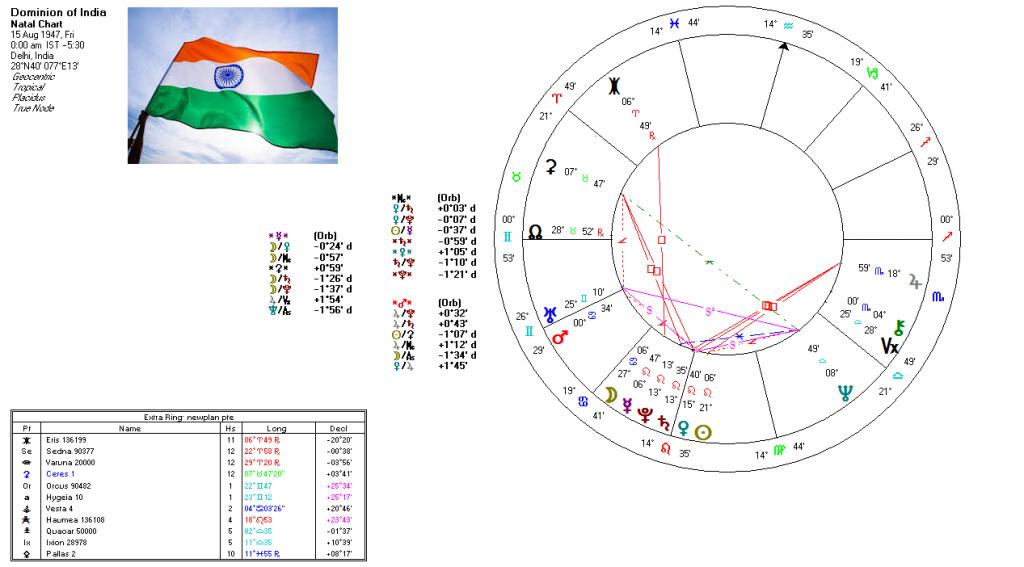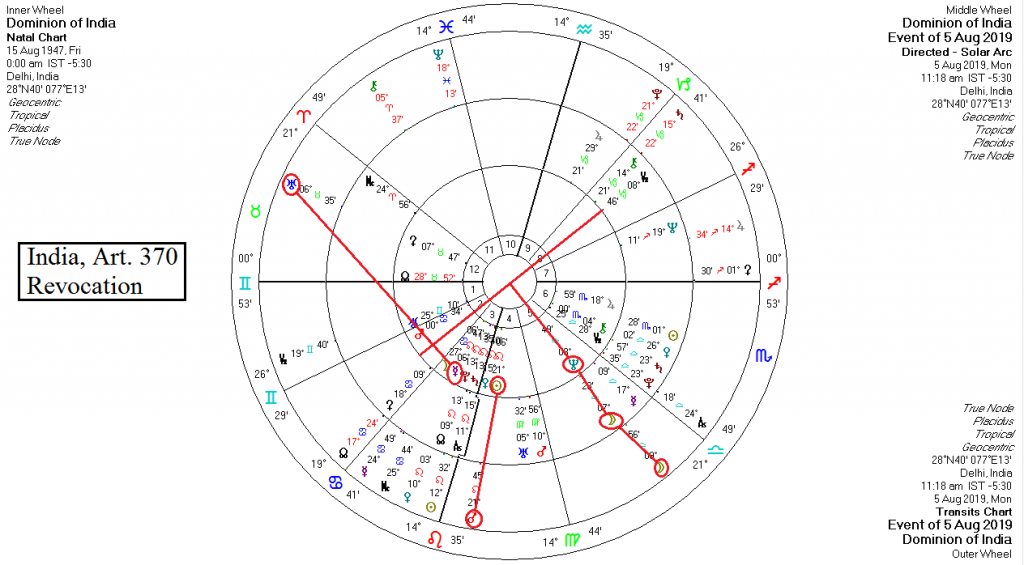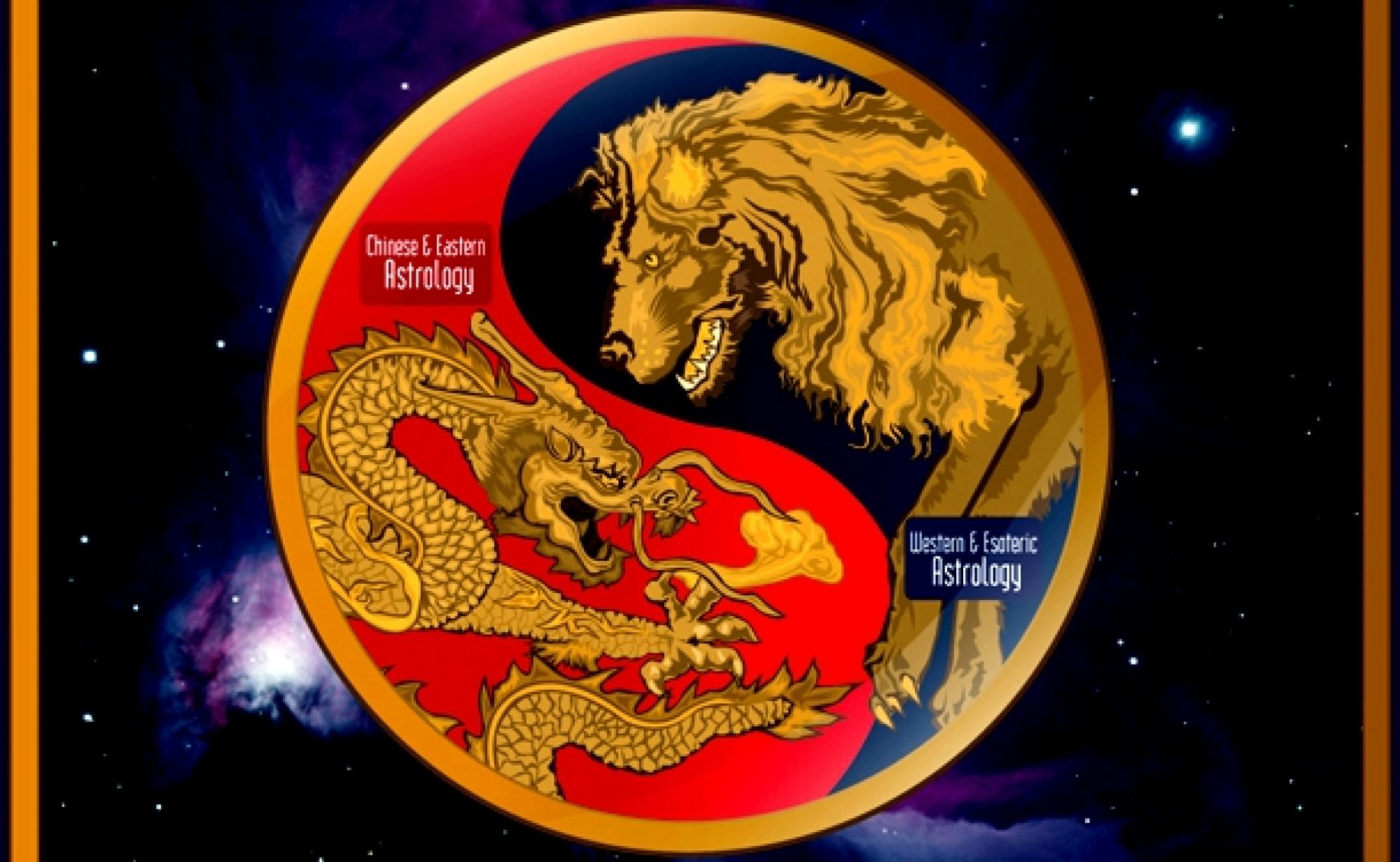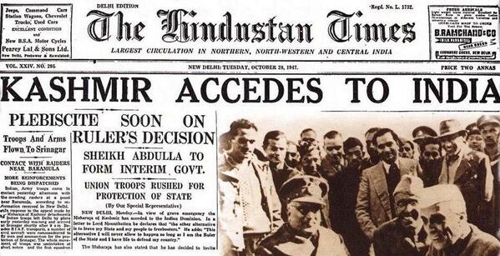Finally, in this third section we will have a look at what the revocation of Article 370 will mean for India and why they went about it. The move has been called a ‘constitutional slight-of-hand’ and illegal, and on the whole it was the fulfillment of a campaign promise by the ruling party. Naturally, it has wide support among the Indian public, but what about the Kashmiris, who were not consulted? What will be the outcome for them? At this point, that is up in the air, but given India’s past behavior there, the outlook is not favorable for Kashmir.
To see why the revocation has taken place we need to have a look at the chart of India at the time of partition. Kashmir was to be an independent state, which would include all of its regions, now administered by three nations. It was to be up to the people of the region to decide their fate via plebiscite, as it would have been for the over 500 other princely states in India, but Kashmir was never given the chance. And given the similarities of India and Pakistan astrologically, the reason Kashmiris were not allowed to decide becomes clear. India’s chart is below (bigger):

We have already discussed Pakistan’s chart. The two main differences between India and Pakistan lie in the angles and in the degree of the Moon. In Pakistan’s chart the Moon is trine Jupiter, which tends toward conservatism, especially in religion, with an emphasis on character rather than dogma. But more than that, it gives a keen sense of right and wrong. The degree of the Moon is also religious in its Sabian symbol: A priest performing a marriage ceremony. Pakistan at this point is closely wedded to China.
India, on the other hand, has its Moon at the last degrees of Cancer, the degree in the Sabians reading: An Indian girl [as in aboriginal American] introduces her white lover to her assembled tribe. This speaks to the diverse and sometimes warring tribal groups that exist in Indian society. The Moon in India’s chart is quintile to Neptune, suggesting religious obsession, but also the possibility of great creative gifts once the crises regarding the affected planets have been resolved.
In India’s chart the Moon is in the 3rd house (commerce, communications, education, etc.) with Neptune in the 5th house (children, creativity in general, avocations, etc.). In other words, both India and Pakistan have religion strongly indicated in their charts, but it expresses differently, with Pakistan being more conventional and India being more obsessive, at least in its present state. But those religious differences were at the heart of the partition between the two nations.
Indian partition caused the greatest humanitarian crisis in modern history, with 15 million people displaced, over a million people killed, largely in rural areas, as they tried to migrate to their newly chosen nations. That crisis is shown in the partition chart (Indian independence chart). There is a partile conjunction of Saturn and Pluto, which is particularly implicated in mass murder (re: Ebertin), and it is square Jupiter, further amplifying the effect. The combination of the three planets can yield, … the inclination to sacrifice oneself for others, religious and social fanaticism…”, which was rife in India at partition.
In addition, the Saturn/Pluto conjunction was on India’s 4th house cusp (infrastructure, homeland security, the land in general), representing the partition of the land and the massive cost in human life and suffering caused by partition.
With India, we find Gemini rising, which has a tendency in nations for governments to play both ends against the middle, to use divisive tactics, to focus on divisions and sectarianism and so forth in its baser manifestations. In its higher form, Gemini rising gives a great inclusiveness, a multicultural flavor, uniting broad swathes of cultures and societies, of which India has hundreds. It is far from being a monolithic culture. Gemini tends toward synthesis – unity in diversity – in the higher expression. That is not what we saw with partition, nor what we see with the revocation of Art. 370. This has played to the Hindu voter base and has ignored the desires of the Kashmiris.
India also has the same basic midpoint structures as does Pakistan, especially the Mars midpoints: Venus/Jupiter, Jupiter/Saturn and Jupiter/Pluto. The Mars midpoints in any chart tend to be reactive unless Neptune is involved. It is worth noting, too, that both nations have Mars out-of-bounds, which serves to increase their volatility and militancy. And since these midpoints are identical between the two charts we see the reactivity between the two nations, which has always existed in modern times. Those midpoints give a driving desire to accomplish great things, and both nations have done so. But the Jupiter/Saturn midpoint can give inconstancy, discontent and a desire to enforce change, which is exactly what we have seen with India in this case. It was also the case at the time of partition, when Pakistan sent insurgents into the Kashmir in an effort to bring it into the Pakistan fold.
Both are Leo Sun nations, with both desiring to be the lead in their bilateral relations, and hence demonstrating their shared destructive pride and intransigence at key junctures, such as this one. And both nations have the Saturn/Pluto/Venus triple conjunction, which lends a coldness to the nature, a desire for solitude and separations. Such a combination can be quite spiritual, as in the case of a penchant for spiritual retreats and the renunciation of worldly goods and status. But in this day and age, when nations are seeking to build their infrastructure and bring people up to modern living standards, such a combination can be rather problematic, as it gives a very hard nose in negotiations and a tendency to be most unyielding.
That triple conjunction also has another feature that is not always stated but is there nonetheless: it gives a profound sense of loyalty. In the case of Pakistan this is most pronounced, as in its relationship with China. They describe their friendship as, “A Friendship Higher than the Heights of Himalayas and deeper than the depths of Arabian Sea”. One rarely if ever hears nations speaking of each other in that manner. But such is their friendship. This is not surprising if one views the synastry of China and Pakistan. Pakistan’s Jupiter sits on China’s Venus, with Pakistan’s Moon trining the two. India has no such friendships, but instead relies on its so-called ‘nonaligned’ status, which comes through its Gemini Ascendant.
Then, if we look at India’s economy, we see Mercury as its ruler (2nd house), with Jupiter ruling its international banking relations (8th house). Mercury also rules India’s 1st house, so the midpoints to Mercury are quite important in understanding India and its economy.
Mercury and Ceres form the foci of the midpoints associated with India’s 1st, 2nd and 5th houses. That places a great importance on the role of women and young people in the society. The midpoints involving the Moon (see chart) give an ability to concentrate, a strong sense of duty and conscientiousness, far-reaching plans pursued with zealousness and an ability to control the narratives within society strongly. These are positives. The Moon/Venus midpoint gives a tendency to concentrate on matters of the heart, a high idealism and a societal fascination with love affairs, as we see in its Bollywood productions. With Mercury ruling the 5th house India’s film industry is booming. There are also a high number of call centers in India.
But all is not roses with India’s Mercury midpoints. There is also the Ascendant/Neptune midpoint, which on the one hand points to India’s great sages and sadhus, along with its long spiritual history. But on the other hand it points to wrong ideas, being led down the garden path, self-deception or the deception of others and scheming manipulation, exploiting other people’s weaknesses. And that brings us to the crux of India’s revocation of Art. 370.
The action was said to be a cover for India’s economic woes, as we saw in the first installment of this series. India suffers from the same economic disease that does most of the world at large: It bought into the neoliberal/financial capitalist order. Its slippery slide down that slope began in 1991 when it asked for an IMF loan, whereby it had to deregulate. India faces considerable internal pressures, too, with its large population, lack of infrastructure, problems with corruption, a lower than average literacy rate, a huge and inefficient bureaucracy, the world’s worst ranking in terms of black money being stashed away in offshore accounts, its renowned caste system (which plagues it to this day), and influence peddling. As if that weren’t enough.
Modi had campaigned for his first term on a platform of jobs creation, on which he failed to deliver. His current election has echoes of what has happened in the US with Donald Trump, with Modi calling himself a self-made man and man of the people, a champion of the lower classes and working stiffs, pledging that he had the means to unleash India’s economic potential and cut red tape, and casting Congressional parties as elitist, out of touch and corrupt. And he capitalized on the February terrorist bombings in Kashmir. He responded militarily by bombing alleged terrorist training camps in Pakistan, which served to fan patriotic fervor in both India and Pakistan, and distracted the voters from his poor performance on his first term. In all the episode was a good example of India’s ability to shape the narrative amongst the public. Modi also relied heavily on social media during the campaign, which is increasingly seen as a must for any political candidate these days.
With the terrorist attacks in February, Modi’s latest campaign focused on tensions with Pakistan:
“Tensions with Pakistan “gave him the narrative he needed to counter all these allegations of non-performance, unemployment and rural distress. It reenergized him and enabled him to reclaim his image as a strong leader India needs at this juncture…”
Given all this, it is perhaps not surprising that Modi pushed to revoke the special status of Kashmir so soon after being elected. That being said, though, what shows in India’s chart with the revocation? The chart with directions and transits is below (bigger):

Transiting Mars was on India’s Sun, as it was for Pakistan, showing a contentious move and an emboldened leadership. The Sun rules India’s 4th house of opposition parties, and also homeland and infrastructure. The revocation potentially adds to India’s land base, in the sense of access to it now being unfettered. But, the move has also energized opposition, which will only become clear later.
Transiting Uranus squared India’s and Pakistan’s shared Mercury, but in the case of India that affects the nation’s Ascendant, economy, educational systems and young people. Indians on the whole, are all for the annexation of Kashmir, but with the involvement of Uranus there are often surprises around the corner.
The biggest talking point, though, is the directed Vertex axis to India’s Neptune, which also received a direction of the Moon at the same time. Also, the directions of the Moon and Vertex activated the following midpoints:
Neptune=Sat/Asc=Plu/Asc=Ven/Asc=Asc/MC=Ven/Node=Sun/Node
Without going into great detail, this points to a dream come true to Indians, but one that is not based in reality, and which may have been prompted by ulterior and/or deceptive motives. It is one that will lead to disappointment if those midpoints hold true. And they likely will.
Since the revocation, Pakistanis have held internal meetings in their Congress and with their military. China has sided with Pakistan, which is not surprising, especially as China has a big stake in the outcome in Kashmir. The rest of the world has called for calm and for dialog. It is still possible that India’s supreme court could rule the action illegal, and there would be precedent, but it is also unlikely. Pakistan has appealed to the UN Security Council. Pakistan has also unequivocally stated there will be no discussions with India over the matter.
Pakistan has been trying to rally support for its cause, but because of its record on supporting terrorism it has failed thus far to garner much support. But what about the Kashmiris themselves? What do they have to say on the matter?
Kashmiris were shocked, disappointed, not really that surprised in another way in many cases, but in general wholly against the idea and reacted negatively. They want a plebiscite on their future. They feel that India’s action is a land grab, as a theft, as being similar to what Israel has done in Palestine, that they will eventually be pushed out of their homes. They are fearful for their future. What they see is India seeking to change the demographics of Kashmir. They are an occupied territory. They do not want to be ruled by India. They weren’t asked what they wanted.
Then, there is the legality of Pakistan’s claims to the region, which is on shaky ground. The Pakistan administered region was gained by invasion in 1947 and thereafter settled by a UN resolution. If India really wanted to press the matter, and since the ex-princely state acceded wholly to India, Pakistan has no real legal right to the area they control. Neither does China. And that is where the ultimate problem lies, and why this decision will not be settled peacefully. There is too much at stake for both Pakistan and China.
With all of this in mind, then, it would appear that India has acted foolishly, but also that it may have been prompted to do so by outside forces. Israel has been suggested, as they have troops who regularly train for mountain combat in the region, increased levels of tourism by Israelis and closer ties between the Israeli and Indian governments, the latter being especially disturbing. The more secretive arm of the US is also a possibility, due to tensions with China. If the latter is the case, it will eventually come to light. But the official story is that this was done for Indian domestic politics. No matter why they did so, this will only come back to haunt them.
The Muslims of Pakistan have deep roots with those in Kashmir, having settled there centuries before India and Pakistan became states. Culture runs far deeper than politics, and Modi will at some point be gone. We can expect violence to escalate over time, but we meditate for peace. It has been suggested that a “Nagaland solution” is the best way forward, which would see Kashmir, the district, become more autonomous in the future. Any dream the Indian elites might have for a return of the territories now occupied by China and Pakistan will remain just that. Kashmir will not be quietly absorbed into the Indian state.
Featured pic from All India Radio News

